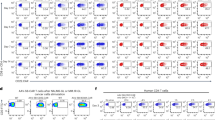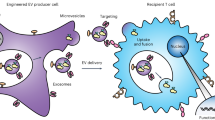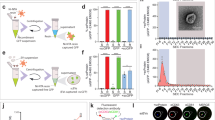Abstract
The TAT protein transduction domain (PTD) has been used to deliver a wide variety of biologically active cargo for the treatment of multiple preclinical disease models, including cancer and stroke. However, the mechanism of transduction remains unknown. Because of the TAT PTD's strong cell-surface binding, early assumptions regarding cellular uptake suggested a direct penetration mechanism across the lipid bilayer by a temperature- and energy-independent process. Here we show, using a transducible TAT–Cre recombinase reporter assay on live cells, that after an initial ionic cell-surface interaction, TAT-fusion proteins are rapidly internalized by lipid raft–dependent macropinocytosis. Transduction was independent of interleukin-2 receptor/raft-, caveolar- and clathrin-mediated endocytosis and phagocytosis. Using this information, we developed a transducible, pH-sensitive, fusogenic dTAT-HA2 peptide that markedly enhanced TAT-Cre escape from macropinosomes. Taken together, these observations provide a scientific basis for the development of new, biologically active, transducible therapeutic molecules.
This is a preview of subscription content, access via your institution
Access options
Subscribe to this journal
Receive 12 print issues and online access
$209.00 per year
only $17.42 per issue
Buy this article
- Purchase on Springer Link
- Instant access to full article PDF
Prices may be subject to local taxes which are calculated during checkout





Similar content being viewed by others
References
Mann, D.A. & Frankel, A.D. Endocytosis and targeting of exogenous HIV-1 Tat protein. EMBO J. 10, 1733–1739 (1991).
Frankel, A. & Pabo, C. Cellular uptake of the Tat protein from human immunodeficiency virus. Cell 55, 1189–1193 (1988).
Green, M. & Loewenstein, P. Autonomous functional domains of chemically synthesized human immunodeficiency virus Tat trans-activator protein. Cell 55, 1179–1188 (1988).
Schwarze, S.R., Ho, A., Vocero-Akbani, A. & Dowdy, S.F. In vivo protein transduction: delivery of a biologically active protein into the mouse. Science 285, 1569–1572 (1999).
Lindsay, M.A. Peptide-mediated cell delivery: application in protein target validation. Curr. Opin. Pharmacol. 2, 587–594 (2002).
Cao, G. et al. In Vivo delivery of a Bcl-xL fusion protein containing the TAT protein transduction domain protects against ischemic brain injury and neuronal apoptosis. J. Neurosci. 22, 5423–5431 (2002).
Wadia, J.S. & Dowdy, S.F. Modulation of cellular function by TAT mediated transduction of full-length proteins. Curr. Protein Pept. Sci. 4, 97–104 (2003).
Fawell, S. et al. Tat-mediated delivery of heterologous proteins into cells. Proc. Natl. Acad. Sci. USA 91, 664–668 (1994).
Vives, E., Richard, J.P., Rispal, C. & Lebleu, B. TAT peptide internalization: seeking the mechanism of entry. Curr. Protein Pept. Sci. 4, 125–132 (2003).
Silhol, M., Tyagi, M., Giacca, M., Lebleu, B. & Vives, E. Different mechanisms for cellular internalization of the HIV-1 Tat-derived cell penetrating peptide and recombinant proteins fused to Tat. Eur. J. Biochem. 269, 494–501 (2002).
Console, S., Marty, C., Garcia-Echeverria, C., Schwendener, R. & Ballmer-Hofer, K. Antennapedia and HIV TAT 'protein transduction domains' promote endocytosis of high Mr cargo upon binding to cell surface glycosaminoglycans. J. Biol. Chem. 278, 35109–35114 (2003).
Lundberg, M., Wikstrom, S. & Johansson, M. Cell surface adherence and endocytosis of protein transduction domains. Mol. Ther. 8, 143–150 (2003).
Tyagi, M., Rusnati, M., Presta, M. & Giacca, M. Internalization of HIV-1 Tat requires cell surface heparan sulfate proteoglycans. J. Biol. Chem. 276, 3254–3261 (2001).
Conner, S.D. & Schmid, S.L. Regulated portals of entry into the cell. Nature 422, 37–44 (2003).
Fittipaldi, A. et al. Cell membrane lipid rafts mediate caveolar endocytosis of HIV-1 tat fusion proteins. J. Biol. Chem. 278, 34141–34149 (2003).
Liu, N.Q. et al. Human immunodeficiency virus type 1 enters brain microvascular endothelia by macropinocytosis dependent on lipid rafts and the mitogen-activated protein kinase signaling pathway. J. Virol. 76, 6689–6700 (2002).
Anderson, R.G. The caveolae membrane system. Annu. Rev. Biochem. 67, 199–225 (1998).
Nichols, B.J. & Lippincott-Schwartz, J. Endocytosis without clathrin coats. Trends Cell Biol. 11, 406–412 (2001).
Razani, B., Woodman, S.E. & Lisanti, M.P. Caveolae: from cell biology to animal physiology. Pharmacol. Rev. 54, 431–467 (2002).
West, M.A., Bretscher, M.S. & Watts, C. Distinct endocytotic pathways in epidermal growth factor-stimulated human carcinoma A431 cells. J. Cell Biol. 109, 2731–2739 (1989).
Sampath, P. & Pollard, T.D. Effects of cytochalasin, phalloidin, and pH on the elongation of actin filaments. Biochemistry 30, 1973–1980 (1991).
Torchilin, V.P., Rammohan, R., Weissig, V. & Levchenko, T.S. TAT peptide on the surface of liposomes affords their efficient intracellular delivery even at low temperature and in the presence of metabolic inhibitors. Proc. Natl. Acad. Sci. USA 98, 8786–8791 (2001).
Lewin, M. et al. Tat peptide-derivatized magnetic nanoparticles allow in vivo tracking and recovery of progenitor cells. Nat. Biotechnol. 18, 410–414 (2000).
Seglen, P.O., Grinde, B. & Solheim, A.E. Inhibition of the lysosomal pathway of protein degradation in isolated rat hepatocytes by ammonia, methylamine, chloroquine and leupeptin. Eur. J. Biochem. 95, 215–225 (1979).
Skehel, J.J., Cross, K., Steinhauer, D. & Wiley, D.C. Influenza fusion peptides. Biochem. Soc. Trans. 29, 623–626 (2001).
Han, X., Bushweller, J.H., Cafiso, D.S. & Tamm, L.K. Membrane structure and fusion-triggering conformational change of the fusion domain from influenza hemagglutinin. Nat. Struct. Biol. 8, 715–720 (2001).
Araki, N., Johnson, M.T. & Swanson, J.A. A role for phosphoinositide 3-kinase in the completion of macropinocytosis and phagocytosis by macrophages. J. Cell Biol. 135, 1249–1260 (1996).
Oliver, J.M., Berlin, R.D. & Davis, B.H. Use of horseradish peroxidase and fluorescent dextrans to study fluid pinocytosis in leukocytes. Methods Enzymol. 108, 336–347 (1984).
Meier, O. et al. Adenovirus triggers macropinocytosis and endosomal leakage together with its clathrin-mediated uptake. J. Cell Biol. 158, 1119–1131 (2002).
Norbury, C.C., Hewlett, L.J., Prescott, A.R., Shastri, N. & Watts, C. Class I MHC presentation of exogenous soluble antigen via macropinocytosis in bone marrow macrophages. Immunity 3, 783–791 (1995).
Acknowledgements
We thank E. Ruley and M. Bessler for providing cell lines; B. Meade, I. Kaplan and L. Gross for technical assistance; and M. Becker-Hapak for critical input. This work was supported by the Howard Hughes Medical Institute (to S.F.D.) and the National Institutes of Health (CA96098 to S.F.D. and HL065418 to R.V.S.).
Author information
Authors and Affiliations
Corresponding author
Ethics declarations
Competing interests
The authors declare no competing financial interests.
Supplementary information
Rights and permissions
About this article
Cite this article
Wadia, J., Stan, R. & Dowdy, S. Transducible TAT-HA fusogenic peptide enhances escape of TAT-fusion proteins after lipid raft macropinocytosis. Nat Med 10, 310–315 (2004). https://doi.org/10.1038/nm996
Received:
Accepted:
Published:
Issue Date:
DOI: https://doi.org/10.1038/nm996
This article is cited by
-
Advancement and application of novel cell-penetrating peptide in cancer management
3 Biotech (2023)
-
Application of Cell Penetrating Peptides as a Promising Drug Carrier to Combat Viral Infections
Molecular Biotechnology (2023)
-
Antimicrobial and Antibiofilm Activity of Synthetic Peptide [W7]KR12-KAEK Against Enterococcus faecalis Strains
Current Microbiology (2023)
-
Deciphering variations in the endocytic uptake of a cell-penetrating peptide: the crucial role of cell culture protocols
Cytotechnology (2023)
-
Cytoplasmic delivery of siRNA using human-derived membrane penetration-enhancing peptide
Journal of Nanobiotechnology (2022)



